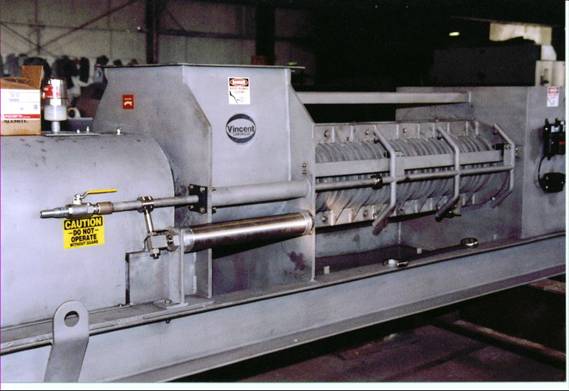Once or twice a year Vincent supplies a screw press with a spray system for cleaning the outside of the screens. This is usually either in food grade applications where USDA regulations require wash down, or in vapor-tight presses where alcohol solutions foul the outside of the screens. The need can also arise on spent grain, where starch cakes on the screens.
These systems usually use high pressure water. Vincent supplies a 5 hp pump to boost the pressure of the plant water to about 225 psi. This makes the cleaning more effective. We mount the pump on a stand with a filter (to keep scale and such out of the nozzles), plus a timer to turn on the pump and open the solenoid valve in the water line, plus another solenoid to send air to the air cylinder that runs the spray rings back and forth. This is shown in the photo.
We did one job where the customer hooked up piping for three fluids: water, caustic and acid. That way they wash with three different liquids, in a sequence that washes off the chemical solutions at the end of the cycle, with water.
We supply these systems either with fixed spray nozzles or with traveling spray rings. With the fixed nozzles, we have four manifolds running the length of the screens, one each at the top right hand, top left hand, bottom right hand, and bottom left hand. These nozzles use a conical spray pattern.
One customer has only two manifolds, at the top of the press. They use a caustic solution that starts at the top and flows by gravity to clean the bottom half of the screens.
With traveling spray rings we use an air cylinder to run the spray back and forth. These nozzles have a fan spray pattern, and they do a more effective job of washing. In presses with long screens, we use three spray rings, each traveling 30″, driven by an air cylinder with a 30″ stroke.
We recently retrofitted wash systems to a pair of 16″ presses in a citrus plant. They did not need the booster pump because they already had high pressure water in the area. The system is not on a timer; they run manually when washing is needed.
A major design consideration is allowing for the screens to be removed from the press without interference from the spray piping.

ISSUE #202
